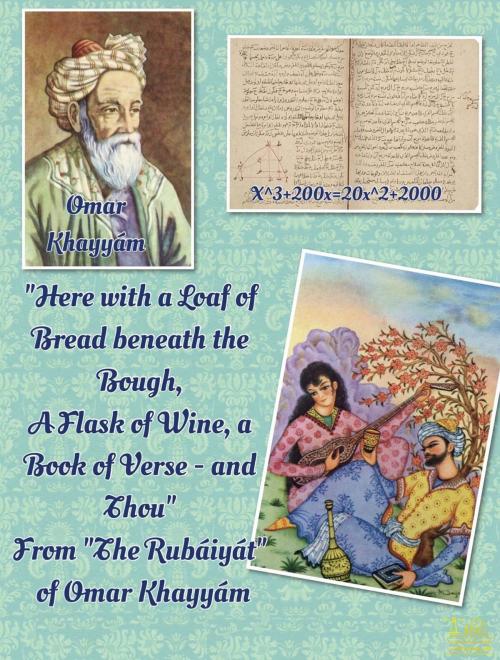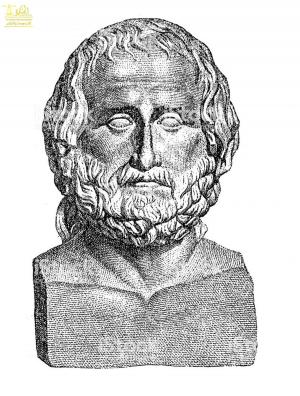Rubaiyat of Omar Khayyam
Nonfiction, Religion & Spirituality, Philosophy, Ancient, Ethics & Moral Philosophy, Fiction & Literature, Poetry| Author: | Omar Khayyam | ISBN: | 9783593306179 |
| Publisher: | Lighthouse Books for Translation Publishing | Publication: | March 27, 2019 |
| Imprint: | Lighthouse Books for Translation and Publishing | Language: | English |
| Author: | Omar Khayyam |
| ISBN: | 9783593306179 |
| Publisher: | Lighthouse Books for Translation Publishing |
| Publication: | March 27, 2019 |
| Imprint: | Lighthouse Books for Translation and Publishing |
| Language: | English |
Omar Khayyam, Arabic in full Ghiyāth al-Dīn Abū al-Fatḥ ʿUmar ibn Ibrāhīm al-Nīsābūrī al-Khayyāmī, (born May 18, 1048, Neyshābūr [also spelled Nīshāpūr], Khorāsān [now Iran]—died December 4, 1131, Neyshābūr), Persian mathematician, astronomer, and poet, renowned in his own country and time for his scientific achievements but chiefly known to English-speaking readers through the translation of a collection of his robāʿīyāt (“quatrains”) in The Rubáiyát of Omar Khayyám (1859), by the English writer Edward FitzGerald.
His name Khayyam (“Tentmaker”) may have been derived from his father’s trade. He received a good education in the sciences and philosophy in his native Neyshābūr before traveling to Samarkand (now in Uzbekistan), where he completed the algebra treatise, Risālah fiʾl-barāhīn ʿalā masāʾil al-jabr waʾl-muqābalah (“Treatise on Demonstration of Problems of Algebra”), on which his mathematical reputation principally rests. In this treatise he gave a systematic discussion of the solution of cubic equations by means of intersecting conic sections. Perhaps it was in the context of this work that he discovered how to extend Abu al-Wafā’s results on the extraction of cube and fourth roots to the extraction of nth roots of numbers for arbitrary whole numbers n.
Quadrilateral of Omar KhayyamOmar Khayyam constructed the quadrilateral shown in the figure in an effort to prove that Euclid's fifth postulate, concerning parallel lines, is superfluous. He began by constructing line segments AD and BC of equal length perpendicular to the line segment AB. Omar recognized that if he could prove that the internal angles at the top of the quadrilateral, formed by connecting C and D, are right angles, then he would have proved that DC is parallel to AB. Although Omar showed that the internal angles at the top are equal (as shown by the proof demonstrated in the figure), he could not prove that they are right angles.
Quadrilateral of Omar KhayyamOmar Khayyam constructed the quadrilateral shown in the figure in an effort to prove that Euclid's fifth postulate, concerning parallel lines, is superfluous. He began by constructing line segments AD and BC of equal length perpendicular to the line segment AB. Omar recognized that if he could prove that the internal angles at the top of the quadrilateral, formed by connecting C and D, are right angles, then he would have proved that DC is parallel to AB. Although Omar showed that the internal angles at the top are equal (as shown by the proof demonstrated in the figure), he could not prove that they are right angles.
Omar Khayyam, Arabic in full Ghiyāth al-Dīn Abū al-Fatḥ ʿUmar ibn Ibrāhīm al-Nīsābūrī al-Khayyāmī, (born May 18, 1048, Neyshābūr [also spelled Nīshāpūr], Khorāsān [now Iran]—died December 4, 1131, Neyshābūr), Persian mathematician, astronomer, and poet, renowned in his own country and time for his scientific achievements but chiefly known to English-speaking readers through the translation of a collection of his robāʿīyāt (“quatrains”) in The Rubáiyát of Omar Khayyám (1859), by the English writer Edward FitzGerald.
His name Khayyam (“Tentmaker”) may have been derived from his father’s trade. He received a good education in the sciences and philosophy in his native Neyshābūr before traveling to Samarkand (now in Uzbekistan), where he completed the algebra treatise, Risālah fiʾl-barāhīn ʿalā masāʾil al-jabr waʾl-muqābalah (“Treatise on Demonstration of Problems of Algebra”), on which his mathematical reputation principally rests. In this treatise he gave a systematic discussion of the solution of cubic equations by means of intersecting conic sections. Perhaps it was in the context of this work that he discovered how to extend Abu al-Wafā’s results on the extraction of cube and fourth roots to the extraction of nth roots of numbers for arbitrary whole numbers n.
Quadrilateral of Omar KhayyamOmar Khayyam constructed the quadrilateral shown in the figure in an effort to prove that Euclid's fifth postulate, concerning parallel lines, is superfluous. He began by constructing line segments AD and BC of equal length perpendicular to the line segment AB. Omar recognized that if he could prove that the internal angles at the top of the quadrilateral, formed by connecting C and D, are right angles, then he would have proved that DC is parallel to AB. Although Omar showed that the internal angles at the top are equal (as shown by the proof demonstrated in the figure), he could not prove that they are right angles.
Quadrilateral of Omar KhayyamOmar Khayyam constructed the quadrilateral shown in the figure in an effort to prove that Euclid's fifth postulate, concerning parallel lines, is superfluous. He began by constructing line segments AD and BC of equal length perpendicular to the line segment AB. Omar recognized that if he could prove that the internal angles at the top of the quadrilateral, formed by connecting C and D, are right angles, then he would have proved that DC is parallel to AB. Although Omar showed that the internal angles at the top are equal (as shown by the proof demonstrated in the figure), he could not prove that they are right angles.















